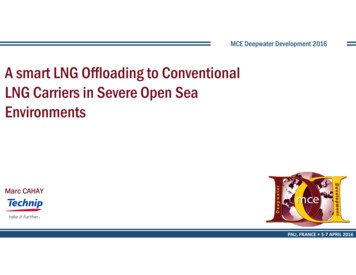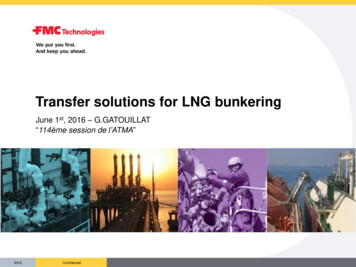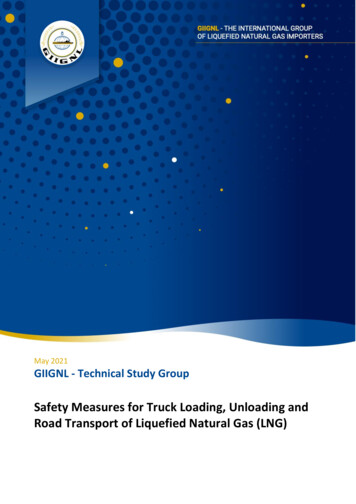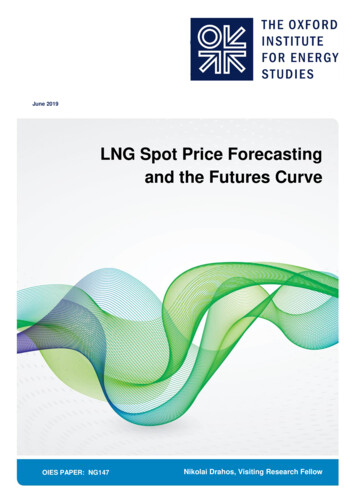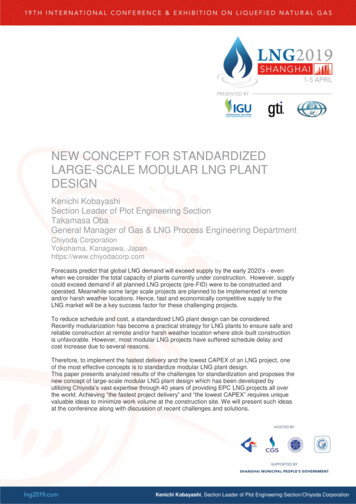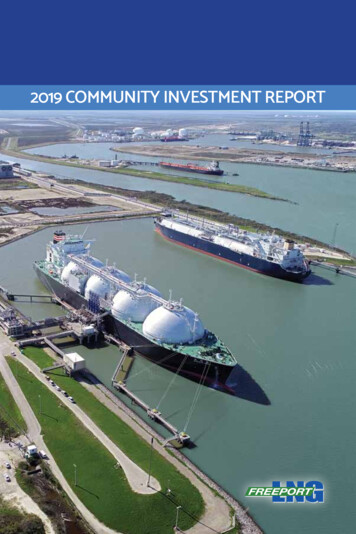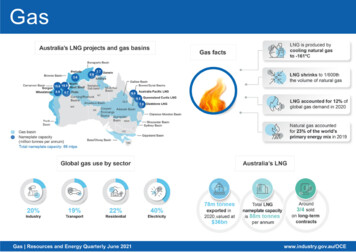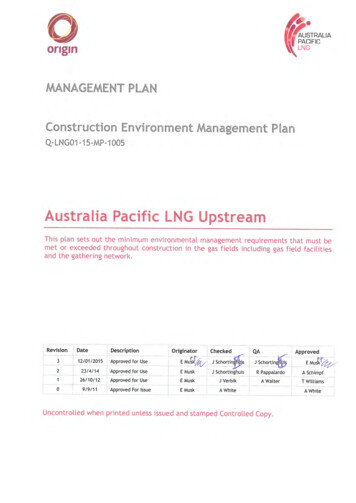
Transcription
Specifications GuideGlobal LNGLatest update: June 2022Definitions of the trading locations for which Plattspublishes daily indexes or assessments2Pacific Basin Spot LNG AssessmentsLNG Derivatives AssessmentsWIM RLNG AssessmentsChina trucked LNG AssessmentsAtlantic Basin LNG AssessmentsLNG Shipping AssessmentsLNG port costsPanama Canal Fresh Water SurchargeConversion ratesLNG Competing Fuels AssessmentsLNG Bunker Fuel AssessmentsCarbon Neutral LNG Assessments31112141521272828292929Revision history31www.spglobal.com/commodityinsights
Specifications GuideGlobal LNG: June 2022DEFINITIONS OF THE TRADING LOCATIONS FOR WHICH PLATTS PUBLISHES DAILY INDEXES OR ASSESSMENTSThe following contains the primary specifications andmethodologies for Platts LNG assessments throughoutthe world. All the assessments listed here employ PlattsAssessments Methodology, as published at https://www.spglobal.com/platts/plattscontent/ assets/ /platts-assessmentsmethodology-guide.pdf.Unit: All prices are quoted in US dollars per million BritishThermal Units ( /MMBtu) to three decimal places. ICENBP futures in pence per therm are converted to /MMBtu usinga USD/GBP exchange rate assessed at market close. Prices atEuropean gas hubs in Euros per megawatt hour are converted to /MMBtu using a USD/EUR exchange rate assessed at marketclose.These guides are designed to give Platts subscribers as muchinformation as possible about a wide range of methodology andspecification questions.Quality: Price assessments reflect Btu/scf calorific value in arange; cargoes outside of this range are considered and may benormalized to within the range.This guide is current at the time of publication. Platts mayissue further updates and enhancements to this guide and willannounce these to subscribers through its usual publicationsof record. Such updates will be included in the next version ofthis guide. Platts editorial staff and managers are available toprovide guidance when assessment issues require clarification.Vessel size: Standard cargoes of 135,000-175,000 cu m. LargerQatari Q-Flex (210,000 cu m) and Q-Max (260,000 cu m) carriersare not assessed directly, though they may be normalized to thestandard volume.Unless otherwise stated, standard specifications for all PlattsLNG assessments are as follows:Frequency: Assessments are published each business day andreflect market values prevailing at the close of markets in therespective region (Singapore/UK/US). On certain days ahead ofa public holiday, such as Christmas Eve or New Year’s Eve, Plattsmay assess the market earlier than normal. This would typicallybe 12:30 pm in Singapore and 12:00 pm in London. 2022 by S&P Global Inc. All rights reserved.2Timing: Platts assesses LNG Delivered Ex-Ship (DES) markets inhalf-month forward cycles, and the FOB Gulf Coast 30-60 daysforward from the date of publication.For instance, on June 1, Platts will assess DES cargoes fordelivery in H1 July, H2 July, H1 August and H2 August in the caseof JKM.The price assessments represent the average of the two halfmonth cycles from the third half-month forward cycle onwardswhich comprise the first full month of delivery. For instance,on June 4, Platts JKM , (Jul) represents the average of priceassessments for cargoes for delivery in H1 July and H2 July.DES price assessments roll over on the 16th of each calendarmonth unless that day is not a business day, in which case theprice assessment rolls over on the following business day. Forinstance, if June 16 is a business day, Platts JKM , (Aug) isthe average of price assessments of cargoes for delivery in H1August and H2 August.Netback & netforward assessments: For all netback andnetforward assessments, Platts publishes a single valuereflecting the implied price of a cargo at market close usingthe freight route costs, which employ standard Platts freightassumptions and relevant journey times to a stated loading ordelivery location. More details are provided in the netback andshipping assessments section below.Commissioning cargoes: Platts LNG price assessments reflectcargoes that are widely merchantable and do not reflect thecommissioning cargoes from a new LNG project site. Thisapplies to bids, offers and trades published during the PlattsLNG Market on Close (MOC) assessment process, meaningthat neither base loading port stated in offers, nor loading portnominations for trades reported via the MOC process shouldbe against LNG liquefaction sites yet to load an LNG cargo,or whose cargo specifications are still unknown to the widermarket.
Specifications GuideGlobal LNG: June 2022PACIFIC BASIN SPOT LNG ASSESSMENTSAssessmentSymbolMavgContract TypeContract Basis Locationmin. sizemax. sizeCurrencyUOMLNG Japan/Korea Spot Crg SDMMBtuLNG Japan/Korea DES 1 75,000USDMMBtuLNG Japan/Korea DES 2 75,000USDMMBtuLNG Japan/Korea DES 3 75,000USDMMBtuLNG Japan/Korea DES 4 75,000USDMMBtuLNG Japan/Korea vs Henry Hub Spore 16:30AAPRZ00AAPRZ03DifferentialUSDMMBtuLNG Japan/Korea vs ADB Spore 16:30AAPSB00AAPSB03DifferentialUSDMMBtuLNG DES JKM vs WIM Spore 16:30LDJWS00LDJWS03DifferentialUSDMMBtuLNG Freight Japan/Korea Vs Taiwan/China 16:30AAPSC00AAPSC03DifferentialUSDMMBtuHHub 1-Mo Spore 16:30 Hrs /MMBtuAAPSD00AAPSD03FuturesHenry HubUSDMMBtuHHub 2-Mo Spore 16:30 Hrs /MMBtuAAPSE00AAPSE03FuturesHenry HubUSDMMBtuDutch TTF Mo01 /MMBtu Singapore CloseDTMSC01DTMSC31FuturesTTF5 MWUSDMMBtuDutch TTF Mo02 /MMBtu Singapore CloseDTMSC02DTMSC32FuturesTTF5 MWUSDMMBtuDutch TTF Mo01 /MMBtu Singapore Close (Mirrored)DTOSC01DTOSC31FuturesTTF5 MWUSDMMBtuDutch TTF Mo02 /MMBtu Singapore Close (Mirrored)DTOSC02DTOSC32FuturesTTF5 MWUSDMMBtuLNG DES JKM Spot vs Dutch TTF Mo01 /MMBtuLNTFJ00LNTFJ03DifferentialTTFUSDMMBtuLNG JKM Spore 16:30 vs NWE Ldn 16:30ALNGA00ALNGA03DifferentialUSDMMBtuLNG JKM Spore 16:30 vs Med Ldn 16:30ALNGB00ALNGB03DifferentialUSDMMBtuLNG FOB Mid East 25-45 DaysAARXQ00AARXQ03SpotFOBMiddle East135,000175,000USDMMBtuLNG DES Middle East Marker MEM Spot Cargo Mo01LMEMA00LMEMA03SpotDESMiddle East135,000175,000USDMMBtuLNG DES Middle East Marker MEM 1 Half-MonthLMEMB00LMEMB03SpotDESMiddle East135,000175,000USDMMBtuLNG DES Middle East Marker MEM 2 Half-MonthLMEMC00LMEMC03SpotDESMiddle East135,000175,000USDMMBtuLNG DES Middle East Marker MEM 3 Half-MonthLMEMD00LMEMD03SpotDESMiddle East135,000175,000USDMMBtuLNG DES Middle East Marker MEM 4 Half-MonthLMEME00LMEME03SpotDESMiddle East135,000175,000USDMMBtuLNG DES Middle East Marker MEM vs Henry Hub 16:30London Mo01LMEMG00LMEMG03SpotDESMiddle EastUSDMMBtuLNG DES Middle East Marker MEM vs JKM 16:30Singapore Mo01LMEMH00LMEMH03SpotDESMiddle EastUSDMMBtuLNG DES Middle East Marker MEM vs NBP 16:30 London Mo01LMEMJ00LMEMJ03SpotDESMiddle EastUSDMMBtuLNG DES Middle East Marker MEM vs DES Northwest Europe LMEMK00LMEMK03SpotDESMiddle EastUSDMMBtuLNG DES Middle East Marker MEM vs DES MediterraneanLMEML00LMEML03SpotDESMiddle EastUSDMMBtuLNG FOB Australia ,000USDMMBtuLNG FOB 75,000USDMMBtuLNG DES West India MarkerAARXS00AARXS03SpotDESWest India135,000175,000USDMMBtuLNG DES West India Marker 1 Half-MonthLMEAA00LMEAA03SpotDESWest India135,000175,000USDMMBtuLNG DES West India Marker 2 Half-MonthLMEAB00LMEAB03SpotDESWest India135,000175,000USDMMBtuLNG DES West India Marker 3 Half-MonthLMEAC00LMEAC03SpotDESWest India135,000175,000USDMMBtuLNG DES West India Marker 4 Half-MonthLMEAD00LMEAD03SpotDESWest India135,000175,000USDMMBtuLNG DES West India Marker 5 Half-MonthLMEAE00LMEAE03SpotDESWest India135,000175,000USDMMBtu 2022 by S&P Global Inc. All rights reserved.3
Specifications GuideGlobal LNG: June 2022PACIFIC BASIN SPOT LNG ASSESSMENTSAssessmentSymbolMavgContract TypeContract Basis Locationmin. sizemax. sizeCurrencyUOMLNG Japan/Korea Spot Crg DES 5,000JPYMMBtuLNG Japan/Korea DES Spot Crg 00CNYMTLNG Japan/Korea DES Spot Crg 5,000CNYMMBtuJKM Monthly Average uJKM Monthly Average uDES West India Marker Monthly Average*AAWIC03SpotDESWest India135,000175,000USDMMBtuJKM Cumulative Moving Average uJKM Cumulative Moving Average uJKM Cumulative Moving Average 000CNYMTJKM Cumulative Moving Average 75,000CNYMMBtuDES West India Marker Cumulative Moving Average USD*AALIC00SpotDESWest India135,000175,000USDMMBtu*Average of assessments between 16th of M-2 and 15th of M-1 for the delivery month (M) 2022 by S&P Global Inc. All rights reserved.4
Specifications GuideGlobal LNG: June 2022Pacific Basin Assessmentspublished conversion factors.Pacific Basin assessments, derivatives and netbacks arepublished each business day and reflect market valuesprevailing at the close of Asian markets, at 4:30 pm Singaporetime. Prices are published in the following Platts services:Natural Gas Alert (PGN), LNG Alert (LNG), Platts LNG Daily, PlattsMarket Data, Platts LNG Navigator and Platts Dimensions Pro.Basis & Location: Cargoes delivered ex-ship (DES) to ports inJapan and South Korea that can receive a minimum cargo size of135,000 cu m.Cross-month delivery cargoes: Platts considers the standarddelivery period for DES cargoes to fall within the same calendarmonth for bids and offers published during the Asia LNG MOCprocess. Bids for cross-month delivery periods may be subject tonormalization when considered in the final assessment price.Consideration of midpoints in delivery period: For deliveryperiods of two days and four days long, the midpoint consideredon the assessment curve would be based on the daily physicalstructure that determines the buyer’s nomination. For example,for a delivery period of March 3-6, the midpoint considered on acurve reflecting a daily contango structure would be March 5.Similarly, for a delivery period of March 3-6, the midpointconsidered on a curve reflecting a daily backwardation structurewould be March 4.For a delivery period of March 7-8, the midpoint considered ona curve reflecting a daily contango structure would be March8. Similarly, for a delivery period of March 7-8, the midpointconsidered on a curve reflecting a daily backwardation structurewould be March 7.Japan/Korea Marker (Platts JKM )Platts launched on February 2, 2009, daily spot Asian LNGassessments under the benchmark name Platts Japan/KoreaMarker (Platts JKM ). Platts also publishes a single value dailyassessment of JKM in JPY/MMBtu, CNY/MMBtu and CNY/mt,calculated using assessed daily currency exchange rates and 2022 by S&P Global Inc. All rights reserved.5Prices of LNG spot cargoes delivered into ports in Taiwan orChina with the same minimum cargo size may be normalizedto basis Japan/Korea, using an assessed deviation cost fromJapan/Korea to Taiwan/China. Platts publishes a single valueassessment for JKM. The assessment is based on confirmedspot transactions, firm bids and offers, indications of value,expressions of interest, or in the absence of liquidity, where aspot transaction would have been concluded.Timing: Cargo delivery in the third, fourth, fifth and sixth halfmonth cycles forward from the date of publication.Platts considers the following trading terms to be typical forthe publication of bids, offers and other transactional data forspot LNG cargoes reflected in its benchmark JKM LNG priceassessments.These standards apply to bids, offers and trades published byPlatts in the MOC price assessment process.Standard Terms: Unless stated otherwise by a counterpartyat the time of providing data for publication, the bids andoffers provided for publication in the MOC should reflect thesefollowing standards, which Platts understands to be broadlytypical in the spot market. Platts may publish bids, offers andtrades for LNG cargoes that carry different terms and conditions,but may normalize these when considered in final, publishedassessments. Participants in the MOC process should clearlystate in submitted bids or offers terms that differ from thesestandards.Delivery Window: The delivery period reflected by bids andoffers should typically be three to five days long, with the buyerto narrow to a one- or two-day delivery window 30 days beforethe first day of the traded initial delivery window. The maximumdelivery period Platts considers for publication in bids, offersand trades in the Asia Pacific LNG MOC assessment process isno greater than five days long.Discharge Location: Bids and offers should typically reflectdelivery into Japan, South Korea, Taiwan and China, withbuyer’s option to nominate discharge country and port. Bidsmust state a specific base discharge port. The location chosensets the conditions for any potential counterparty consideringtrading. For transactions concluded and reported through theMOC process, buyers must nominate delivery country, and aspecific port within that country, at least 30 days before thefirst day of the traded delivery window. Buyers retain the optionto substitute delivery port within the same country up to 15days before the first day of the traded delivery window, subjectto ship shore compatibility study (SSCS). Platts considers 15days before the first day of the traded delivery window to be thestandard for same country port nominations, but Platts mayconsider for publication bids and offers with 20 days as thenomination deadline for this term.Loading location: Platts solely publishes bids, offers and tradeswhere sellers have the option to nominate the loading port andmay substitute loading port up to 30 days prior to the first day ofthe traded delivery window subject to the Gross Heating Value(GHV) quality range reported in the trade. Offers for cargoes fordelivery at or less than 45 days from the date of assessmentmust explicitly state a base loading port.Quality: Market participants should clearly state qualityspecifications in bids and offers submitted for publication.Platts JKM assessments reflect cargoes with a GHV of 10301130 Btu/scf, maximum total sulfur content of 5mg/Nm3 andmaximum ethane content of 10%/mol. Unless explicitly stated,these will be the assumed specifications for bids, offers andtrades reported during the MOC process. Bids, offers and tradesthat differ from the standard specification will continue to be
Specifications GuideGlobal LNG: June 2022published. Platts may normalize bids, offers and trades forquality specifications with different GHV ranges, as well as fordifferent total sulfur or ethane content limits.Quantity: The standard cargo quantity reflected in JKM is 3.4TBtu. Platts considers for publication bids, offers and tradesfor other cargo sizes, but may normalize these for assessmentpurposes to the standard value of 3.4 TBtu. Offers with cargovolumes submitted in a range during the APAC LNG MOCprocess are subject to normalization when considered in thefinal assessment price. The maximum volume range stated inthese offers should be no greater than 0.3 TBtu. An exampleof an offer with a 0.3 TBtu quantity range would be 3.2 to 3.5TBtu, with a /-5% operational tolerance, or optol. For offers orbids submitted in a volume range, the specific volume shouldbe declared by the seller 30 days prior to delivery, and thisdeclaration deadline should be stated in the offer or bid. Plattsconsiders the standard optol to be /-5% at the seller’s option,and only considers bids where the optol is /-5% at the seller’soption.LNG Vessel: Platts JKM reflects a vessel size range of135,000-175,000 m3. Sellers must nominate an LNG ship either45 days prior to the first day of the traded delivery windowor state the base vessel in the offer for more prompt deliverywindows. Sellers may substitute delivery vessel up to 30 daysprior to the first day of the traded delivery window subject toSSCS. For cargoes for delivery at or less than 30 days fromthe date of assessment, sellers should state the LNG vesselexplicitly.For a bid submitted for publication in the MOC process,compatibility of the base delivery vessel is required. Similarly,for an offer submitted for publication during the MOC process,compatibility of the base discharge port is required should thebase vessel be named.All delivery vessels are subject to SSCS, in line with standardmarket practices. Platts does not publish bids, offers and trades 2022 by S&P Global Inc. All rights reserved.6requiring delivery vessels to be already compatible or alreadySSCS compatible with discharge ports. Platts expects parties tobe reasonable when exceptional circumstances require sellersto substitute vessels or buyers to substitute terminals beyondtypical standards stated in Platts MOC guidelines. Companiesmust promptly communicate to their counterparties whensuch a substitution is required. Buyers or sellers should notunreasonably withhold substitutions or hamper the establisheddelivery process.For a cargo delivered against an MOC trade, a seller must ensurethat an ETA notice of the nominated LNG ship to the dischargeport is provided to the buyer upon the ship’s departure fromthe loading port, or as soon as reasonably possible. If such adeparture occurs prior to the nomination of the LNG ship, theseller must ensure the initial ETA notice is given as soon asreasonably possible. The seller must also notify the buyer of anymaterial changes to the ETA as soon as the seller is aware ofthese changes.In the event that a physical cargo offer is repeated after a trade,the seller must inform Platts editors of a different base vesselto the one published for the initial reported trade. The newbase vessel stated in the reoffer should be commensurate withthe base vessel in the initially reported trade. Platts will notpublish reoffers if the new base vessel information has not beenprovided.Outright & floating prices: Platts considers a variety of inputs,including outright price bids and offers and floating pricebids and offers in JKM. Participants in the Platts MOC priceassessment process may submit bids and offers for publicationthat price as a differential to an underlying benchmark. Allfloating indications should clearly state the pricing period, forexample “average of JKM published Jul 16-Aug 15”.Platts establishes the hedgeable, outright value of floating andspread price indications by applying them to the observable,prevailing value of underlying relevant derivatives instruments.The objective is to assess the prevailing tradable outright priceof the commodity at the market close.In the event of an observed conflict between outright values andfloating price information, outright values prevail in Platts finalpublished assessments. For example, an outright price bid oroffer (i.e. 11.50/MMBtu) may invalidate a floating price basisbid or offer (i.e. JKM plus 1.00/MMBtu) during the assessmentprocess if the prices demonstrably coexist in conflict at anymoment in time.For physical floating price bids, offers and trades, Plattsprioritizes these based on the relative transparency of thebids, offers and trades reported to Platts on these derivativesinstruments.Should derivative bids, offers and trades be reportedtransparently through the MOC process for an instrument,Platts establishes a value for the derivative instrument thatwould be given priority in the physical MOC assessment processwhen compared with values resulting from derivative bid, offerand trade information that lacks equivalent transparency, forexample anonymous information, or bids or offers that do notdemonstrate value incrementally.When determining the flat price equivalent of a floating pricetrade Platts considers the value of the derivative at the timeof trade. For a bid or an offer left standing up until the marketclose, Platts would use the derivative value at the close ofthe MOC process to convert the floating price to a flat priceequivalent.Standard nomination deadlines: Platts considers for publicationonly bids and offers that reflect its existing editorial guidelineson nomination deadlines for the JKM assessment in the LNGMOC process. Platts will, however, continue to publish bids andoffers with varying delivery port nomination deadlines within thesame country, as well as varying volume nomination deadlines,and these will be subject to normalization. Furthermore, Platts
Specifications GuideGlobal LNG: June 2022considers for publication bids and offers with nominationdeadlines for discharge port and delivery window that align withdeadlines for load port, cargo volume and LNG vessel. Suchnomination deadlines should fall on the same day -- either 30days prior to the final delivery window, or 30 days prior to thetraded initial delivery window.Platts JKM DerivativesPlatts publishes daily Asian LNG derivative assessments underthe name DES Japan/Korea Marker (Platts JKM ) derivatives.These are assessed at 4:30 pm Singapore time and 4:30 pmLondon time, except JKM balance-month next-day derivativeassessment which is assessed at 4:30 pm Singapore time.The assessments are published following editorial engagementwith market participants such as producers, consumers, traders,brokers and other active spot market participants.Timing: Derivative prices are assessed for JKM pricing month,balance-month next-day, one month forward from the physicalJKM, two months forward and three months forward, the nexttwo active quarters, the next two active seasons and the activethree forward calendar years. For example, on June 1, Plattsassesses the physical JKM for July delivery, and assessesJKM derivatives for balance-month next-day July, July, August,September and October. The derivatives assessments roll overon the 16th of each calendar month unless that day is not abusiness day, in which case the assessment rolls over on thefollowing business day. For example, if June 16 is a business day,the JKM derivatives assessments roll over to August, September,October and November. For balance-month next-day derivative,this assessment is published from the first publication day ofthe new pricing month and ends two business days before theend of the pricing month. For example, if July 13 is a businessday, the JKM balance-month ND August assessment is availablefrom June 16 to July 13.Platts assesses two quarters, with each quarterly assessment 2022 by S&P Global Inc. All rights reserved.7rolling as pricing begins on the first month of each new quarter.For example, on February 14, 2020, with the front monthderivative of March, Platts will assess Q2 2020 and Q3 2020. OnFebruary 17, 2020 when the front-month derivative rolls to April,Platts will assess Q3 2020 and Q4 2020.Seasons are defined as follows: Summer represents Aprilto September, and Winter represents October to March. Theseasonal assessment rolls over on the first pricing day whenJKM’s pricing month is either April or October. For example, onFebruary 17, 2020, Platts will assess Winter 2020 and Summer2021 prices. On August 17, 2020, Platts will assess Summer2021 and Winter 2021 prices.The Calendar Year assessment rolls over on the first businessday of the year. For example, in H2 December 2019, Plattsassesses JKM forward curve periods: February, March, April,May, Q2 2020, Q3 2020, Summer 2020, Winter 2020, Cal 2020,Cal 2021 and Cal 2022. In H1 January 2020, the forward curveperiods are: February, March, April, May, Q2 2020, Q3 2020,Summer 2020, Winter 2020, Cal 2021, Cal 2022 and Cal 2023.Settlement: The Platts JKM derivative is financially settledagainst the average of the physical spot Platts JKM assessments. For example, the August JKM derivative will besettled against the average of the daily assessments for Augustphysical JKM, published between June 16 and July 15.Platts will publish bids, offers and expressions of interest totrade from approved participants in the JKM Derivatives MOCprocess in line with the following editorial standards andguidelines:Submitting bids, offers and intentions to trade: Buyersand sellers must submit any bids and offers with completeinformation to Platts editors by phone, instant message or emailbefore 16:10:00 Singapore time or 08:10:00 GMT. Platts expectsparticipants to clearly state all the relevant information whensubmitting a bid or offer for publication, including price, contractperiod and volume. Platts may request further informationfrom participants to ensure clarity. Buyers and sellers maywithdraw their bids or offers at any time during the MOC bycommunicating the same to Platts editors, so long as interest intrading against the published bid or offer has not already beenreceived by Platts. Counterparties must clearly communicatetheir interest to trade a published bid or offer to Platts editors.Bids or offers that are traded in the MOC may be repeated at thesame or a less competitive price.Volume: Platts requires participants to bid or offer LNGderivatives at a minimum size of 250,000 MMBtu (25 lots), andmultiples thereof.Credit and trading terms: Transactions for LNG derivativesreported in the MOC should reflect counterparts’ standard creditand trading terms.Carbon Neutral LNGPlatts publishes spot assessments reflecting the fair value ofcarbon neutral LNG (CNL) from Australia into the Japan/Korea/Taiwan/China (JKTC) region on well-to-tank (WTT), well-to-wire(WTW) and well-to-flange (DES) basis. These assessmentsuse the Platts CNC carbon price assessment as the basis ofthe cost of carbon credits purchased and retired to offset thecarbon emissions from an LNG cargo. Platts also publishes anassessment reflecting the cost to offset the combustion leg of aCNL trade in North Asia.CNL WTT JKTC differential assessment: This assessmentreflects greenhouse gas emissions offset on a WTT basisand takes into consideration emissions associated withproduction, liquefaction, freight (including ballast leg) andregasification. Platts uses a monthly modeled carbon intensity(CI) calculation provided by S&P Global Commodity InsightsAnalytics as the basis of the carbon dioxide equivalent (CO2e)emissions stemming from production and liquefaction at everyLNG production site in Australia and weights these emission
Specifications GuideGlobal LNG: June 2022levels by their 2021 LNG production volume to determine theupstream segment of emissions. Platts uses an estimate ofCO2e emissions stemming from a round-trip (laden and ballastlegs) of a TFDE LNG carrier on the Australia-JKTC route as wellas regasification in JKTC terminals to arrive at the total WTTemissions value.CNL WTW JKTC differential assessment: This assessmentreflects the cost to offset CO2e emissions for the full life cycle ofan LNG cargo delivered to JKTC from Australia. The terms wellto-wheel or well-to-wire are also used to describe this type oftrade.CNL DES JKTC differential assessment: This well-to-flange DESassessment reflects the cost to offset CO2e emissions of an LNGshipment from Australia delivered ex-ship to JKTC at the flangesof the discharge port.CNL Combustion JKTC assessment: This assessment reflectsthe cost to offset the combustion leg of a CNL trade in NorthAsia. This will be an estimate of the cost to offset CO2eemissions associated with internal pipeline transport andcombustion of re-gasified LNG in the JKTC region.Frequency: These daily assessments follow a Singaporepublishing schedule. As Platts CNC forms part of thecalculations, but runs on the UK publishing schedule, Platts CNLassessments are published after the CNC market closes. Ondays where there is a UK public holiday, but not a public holidayin Singapore, the CNL assessments use the last available CNCprice in their calculations.Basis, Location and Quantity: Platts CNL assessments reflectLNG produced and liquefied in Australia and shipped in a TFDEcarrier to JKTC, based on the standard cargo volume of 3.4 TBtureflected in the Platts JKM assessment.Unit: CNL assessments are published in /MMBtu. 2022 by S&P Global Inc. All rights reserved.8For more information on Platts CNC (CNCAD00), which isa spot assessment reflecting the tradable price of naturebased voluntary carbon credits, please consult the followingmethodology document: sition/carbon-credits.Platts West India Marker (WIM)Platts publishes daily WIM LNG assessments for a total of fivehalf-month periods. Platts assesses cargoes for delivery in thesecond, third, fourth, fifth and sixth half-month cycles forwardfrom the date of publication. The WIM monthly assessment isbased on the average of the two DES West India Marker halfmonths that match the JKM delivery month period.The assessment is published following editorial engagementwith producers, consumers, traders, brokers, shippers and otheractive spot market participants.Basis & Location: Cargoes delivered ex-ship (DES) at ports onthe west coast of India that can receive a minimum cargo size of135,000 cu m.Assessment: Platts publishes a single value indicating theprice at which a cargo could be traded at the close of theMOC process. This assessed value is based on confirmed spottransactions, firm bids and offers, indications of value andexpressions of interest, or in the absence of liquidity, where aspot transaction would have been concluded.Timing: Cargo delivery for Platts WIM monthly assessmentmatches the month of Platts JKM .Standard Terms: Unless stated otherwise by a counterpartyat the time of providing data for publication, the bids a
Qatari Q-Flex (210,000 cu m) and Q-Max (260,000 cu m) carriers are not assessed directly, though they may be normalized to the standard volume. Timing: Platts assesses LNG Delivered Ex-Ship (DES) markets in half-month forward cycles, and the FOB Gulf Coast 30-60 days forward from the date of publication.
